Boost SMB Success: Integrate Generative AI Marketing Tools for Platform Growth
Small- and medium-sized businesses (SMBs) face ongoing challenges when attempting to market effectively—often hindered by limited budgets, lack of dedicated staff, and insufficient marketing expertise.
They frequently struggle with pivotal questions: Should they do marketing in-house, hire an expensive agency, DIY on limited knowledge, or avoid investing altogether?
Because the tasks required for SMB success are not inherently complex, SMBs make an ideal use case for AI-driven marketing solutions. Much of what SMBs need—like creating local SEO pages or analyzing website performance—follows well-defined, repeatable workflows.
AI can streamline these tasks cost-effectively, saving the business owner precious time and reducing the expertise barrier.
Platforms serving SMBs can address these marketing pain points head-on, creating substantial value for their users and unlocking new revenue streams simultaneously. This post examines the realities of SMB marketing budgets, assesses traditional approaches, and highlights the compelling potential of AI-embedded marketing features.
Understanding Current SMB Marketing Spend
Before diving into marketing solutions, it's critical to clearly understand what SMBs typically spend on marketing and what results they typically achieve.
Average Monthly and Annual SMB Marketing Budgets
Marketing budgets for SMBs vary significantly by industry, growth stage, and business goals. Typically, SMB spending falls into these general categories:
Micro-Businesses and Sole Proprietors:
Many spend relatively modest amounts, with 24% of SMBs spending less than $500 per month, with 31% of these businesses being more likely to have no full-time marketing staff. They rely heavily on grassroots strategies like word-of-mouth or basic digital efforts.
Growing SMBs:
As businesses grow more ambitious in seeking new audiences, many SMBs’ monthly investment often increases to between $1,000-$2,499, potentially covering SEO, digital ads, email marketing, and focused content campaigns.
Established SMBs:
Larger-scale SMBs, often with multiple teams, locations, or higher revenue targets, may have marketing budgets exceeding $20,000 annually. They utilize diverse channels such as media buys, paid search advertising, events, PR, and advanced digital marketing solutions to achieve their goals.
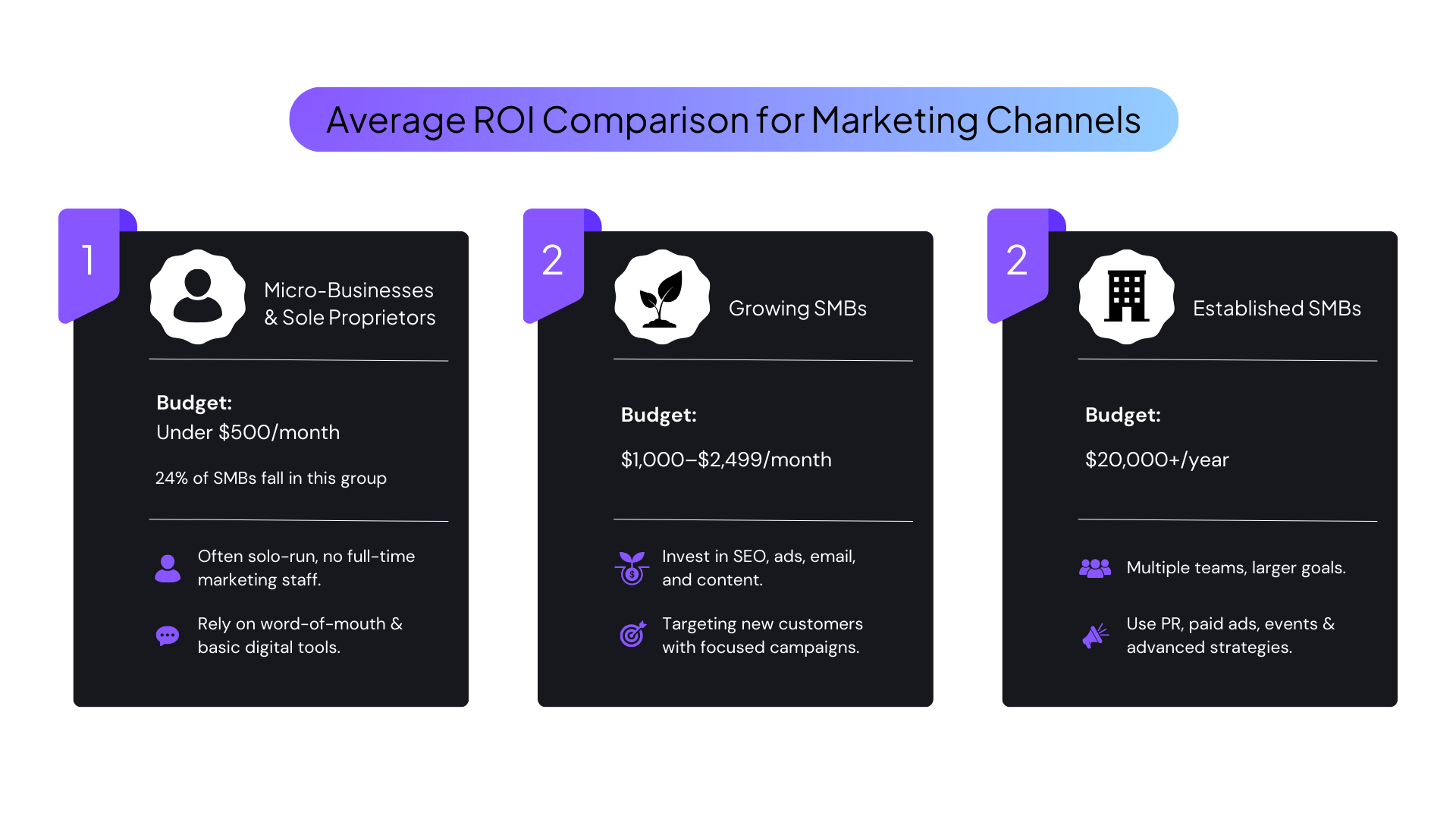
It's clear that smaller businesses often find themselves managing tight budgets and limited resources, impacting their ability to engage in comprehensive marketing strategies. Meanwhile, those in a growth phase recognize the importance of increasing their marketing investment to reach new audiences. Established SMBs, on the other hand, utilize diverse channels to strengthen their market presence. Each growth stage demands unique marketing approaches to effectively meet their objectives.
Expected Results and ROI Benchmarks
Determining the typical ROI and results for SMBs investing in marketing is essential when weighing future strategies. Common results SMBs aim for and often attain with strategic marketing typically include:
- A marketing ROI centered on the importance of return on investment, with 60% of businesses considering it a top metric.
- Revenue growth influenced by a strategic focus on lead acquisition and sales, often driving more leads as budget allocations increase.
- Encouraging repeat purchases, referrals, and brand engagement due to constant nurturing and targeted promotions.
By comparing their budgets and results to industry benchmarks, SMBs can better pinpoint strategies that align with their growth stage and resources. Recognizing where they stand helps each marketing dollar work harder—fostering sustainable growth, maximizing ROI, and laying a strong foundation for long-term success.
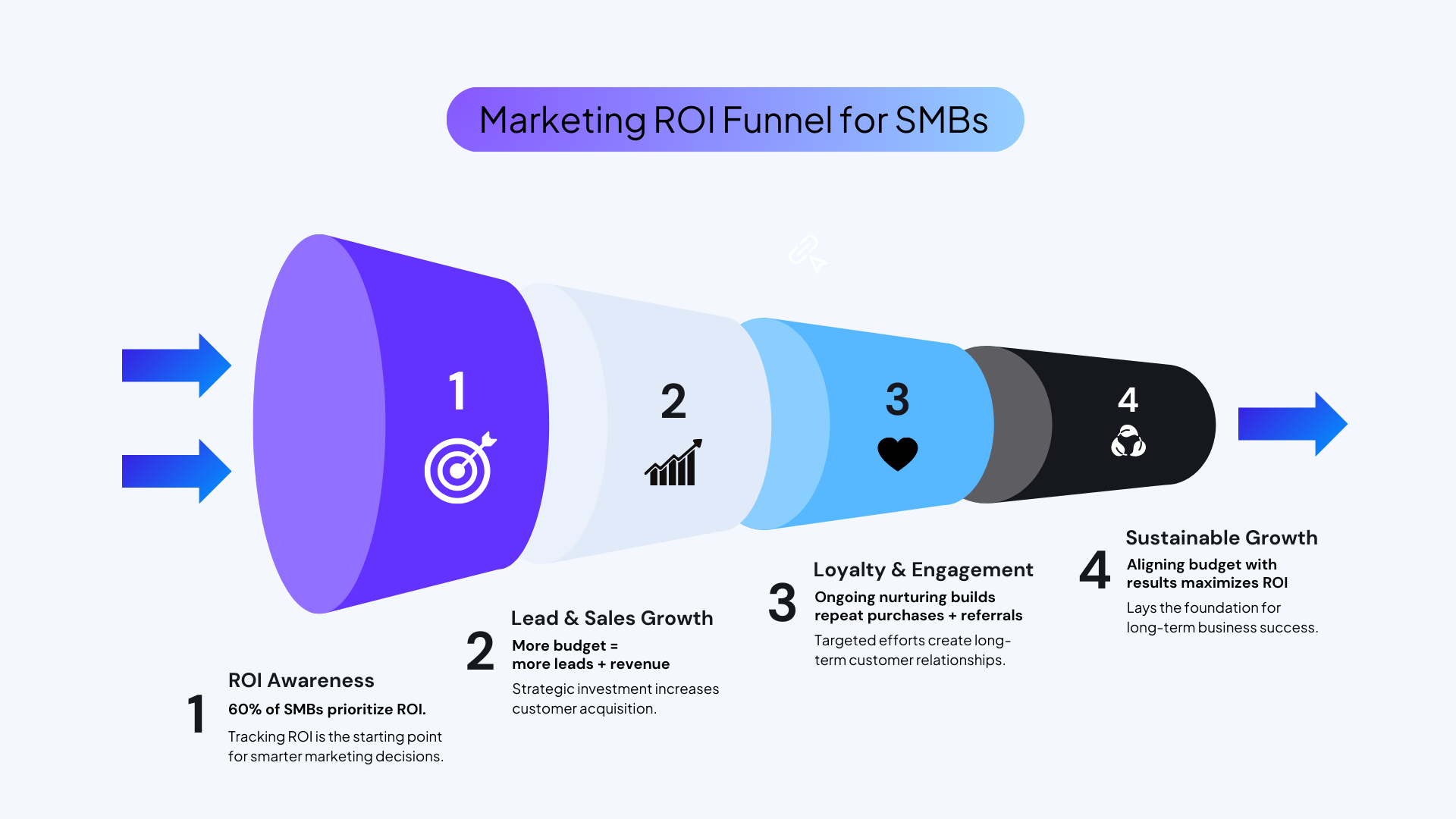
Ready to Elevate Your CRM Experience?
Discover how AgencyEngine combines AI website builder technology, marketing automation, and local SEO capabilities into one integrated marketing platform.
Evaluating Typical Marketing Approaches
Let’s examine the marketing paths typically considered by SMBs, along with their costs, benefits, risks, and overall impact:
Option 1: Rely on Traditional Marketing (And Skip Digital)
Doing nothing (or doing very little) in the digital space often appears financially “safest” for SMBs with limited time and stretched resources. Some SMBs still depend on flyers, print ads, and word-of-mouth, seeing digital marketing as cumbersome or cost-prohibitive. However, this approach often leads to stagnant visibility:
- Nearly 28% of SMBs lack a website, missing a vital channel for credibility and online discovery
- 56% of local businesses still do not have a Google Business Profile (GBP), forfeiting substantial free local SEO opportunities
- Other no cost digital marketing like online listings and business directories have an investment rate of 28%, with reputation management at 19%
Remaining reliant on traditional marketing alone carries steep opportunity costs:
- Minimal reach in an environment where consumers increasingly expect digital interactions.
- Reduced competitiveness, as online channels remain unexploited for brand awareness and lead generation.
- Lower long-term growth potential when compared to peers investing consistently in digital strategies.
Some SMBs remain overwhelmed by the perceived complexity of establishing and maintaining an online presence, often underestimating the long-term benefits of digital marketing. Yet in an era where customers expect a robust digital footprint, relying solely on traditional methods can hinder stability and growth.
Option 2: DIY Marketing vs. Basic Agency Services
Many SMB owners opt to handle their own marketing, believing a do‑it‑yourself approach is more cost‑effective. Others invest modestly—often $500–$2,500 per month—in basic agency services that cover foundational needs.
These two options account for around 19% of SMBs currently investing in digital marketing. While both paths cater to those who want to avoid high consulting fees or large‑scale campaigns, each carries unique constraints and trade‑offs.
DIY Marketing
- Limited Hours: Owners may devote 1–10 hours per week (or more) on tasks like content updates, basic SEO, or monitoring ads—time often pulled away from core operations.
- A Steep Learning Curve: The learning curve in areas like paid advertising, advanced SEO, or analytics can be overwhelming, causing inconsistent results and potential frustration.
- Blind Spots: Blind spots are also common; without external expertise, SMBs risk missing high‑value opportunities in competitive markets.
- Hidden Costs and Limited Budget: Factoring in expenses for tools (e.g., CMS licensing) plus the hidden cost of trial‑and‑error, a DIY route may prove less budget‑friendly than it seems.
Basic Agency Package
At this level, agencies typically offer website setup, content creation, and fundamental technical/content‑driven SEO—along with smaller, recurring tasks which can cost up to $2,500 per month. Some of these tasks are spread over the course of 6 to 12 months.
For example:
- Initial Setup (Month 1-3): Involves website setup and basic SEO tasks, which can seem cost-effective but miss nuanced strategies and efficiencies of a higher cost agency or AI-driven options.
- Ongoing Optimization (Month 4-6): Routine citation checks and content updates. While organized, the costs may escalate due to the complexity. Some Agencies may wait until month 4-6 to complete basic tasks like setting up an FAQ page, delaying results.
- Content and Link Building (Month 7-9): Agencies focus on high-value link-building, which requires expertise—often at a higher cost.
- Quarterly Reviews (Month 10-12): Regular assessments can become overwhelming and costly, potentially overshadowing perceived savings.
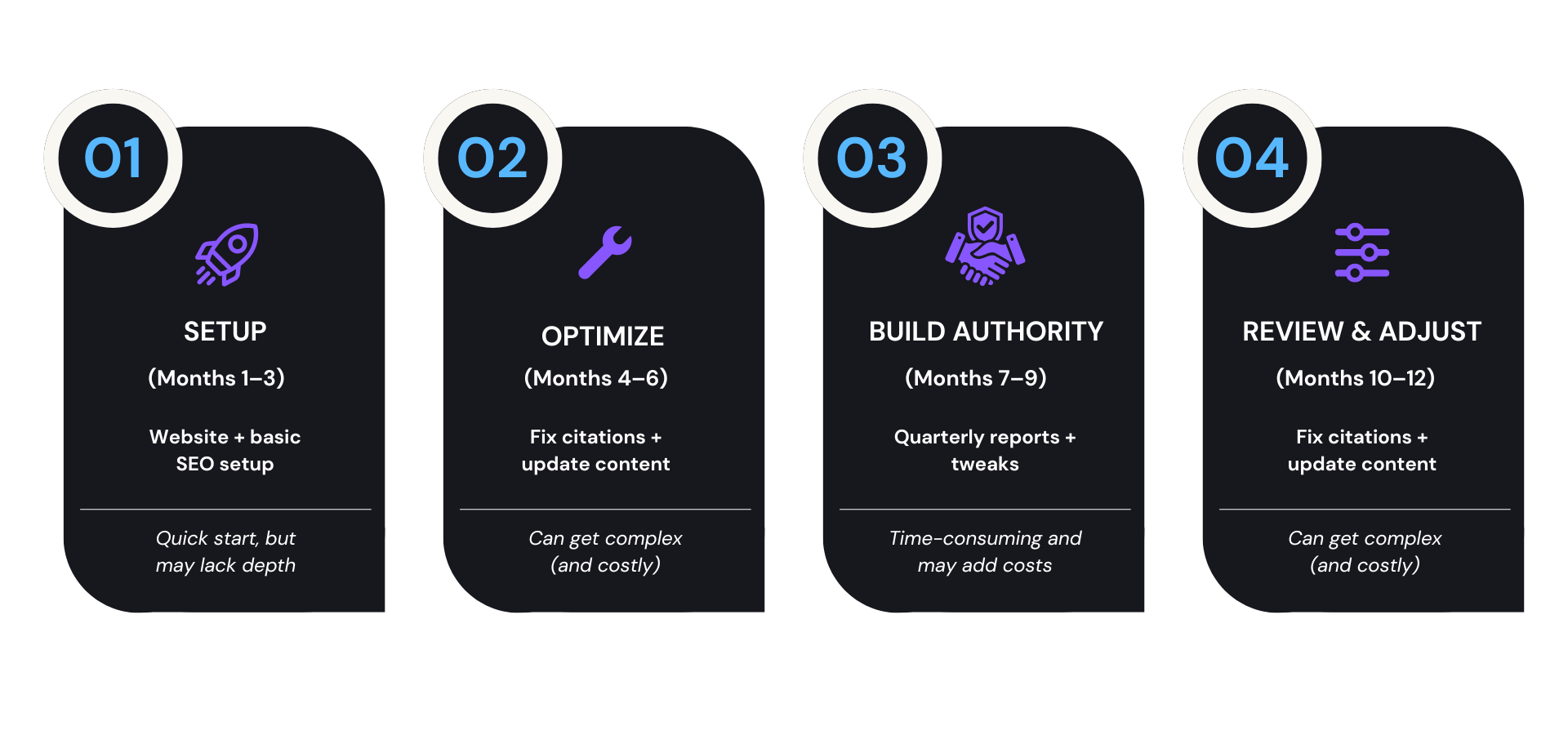
While many agencies in this price bracket rely on standard templates to keep initial costs lower, better providers tailor their approach by auditing local competitors and industry best practices—an often pricier process that can yield more sustainable results.
The extensive checklist of small deliverables might feel overwhelming and can escalate monthly fees, yet consistently executing these tasks often spells the difference between highly targeted, successful marketing and a generic presence that fails to convert visitors into real leads.
Overall, basic agency packages and modest agency engagement can suit SMBs that lack the budget for full‑scale marketing campaigns or custom consulting. However, SMBs should remain aware of the opportunity costs—such as missed leads, learning‑curve pitfalls, and potentially lackluster brand visibility—before deciding which route is the most viable for their immediate and long‑term goals.
Option 3: Hiring a Marketing Agency (Professional Quality at High Cost)
Premium marketing agencies can deliver advanced capabilities that go well beyond basic or mid-tier services—ranging from authority-building backlink strategies and proactive online reputation management (via BBB accreditation, local trust signals, and community recognition) to large-scale paid advertising campaigns and in-depth analytics tied to CRM data.
However, these advantages carry significant trade-offs:
• Monthly Fees: Monthly fees of $5,000–$20,000 can exceed the financial capacity of almost 70% of SMBs.
• Lack of Personalization: Handing over most day-to-day digital communication and brand messaging may reduce an owner’s personalized voice and direct oversight.
• Even at a premium level, certain tasks—such as handling highly specific customer reviews or inquiries—are best managed internally by staff with firsthand knowledge.
In short, partnering with a premium agency represents the most bespoke digital marketing route available, offering a high degree of strategic customization and professional execution. Yet, the substantial price tag can be prohibitive for those not ready to invest at this level.
Option 4: Building an In-House Marketing Team
Establishing a full in-house marketing team seems ideal for long-term strategic alignment but requires considerable investment:
- Annual expenses (including salaries, benefits, office space, tools, training) commonly surpass $100,000–$150,000 even for relatively small teams.
- High fixed costs can limit flexibility and responsiveness if business conditions change or if urgent strategy pivots become necessary.
Given these evaluations, SMBs are increasingly exploring alternative solutions that effectively balance quality, cost, scalability, and simplicity. As technology evolves, embracing AI-powered tools offers a transformative opportunity. By leveraging AI, SMBs can automate routine tasks, gain valuable insights about their competitors and performance, and enhance decision-making. This not only reduces overhead but also elevates marketing efforts to new heights of precision and impact.
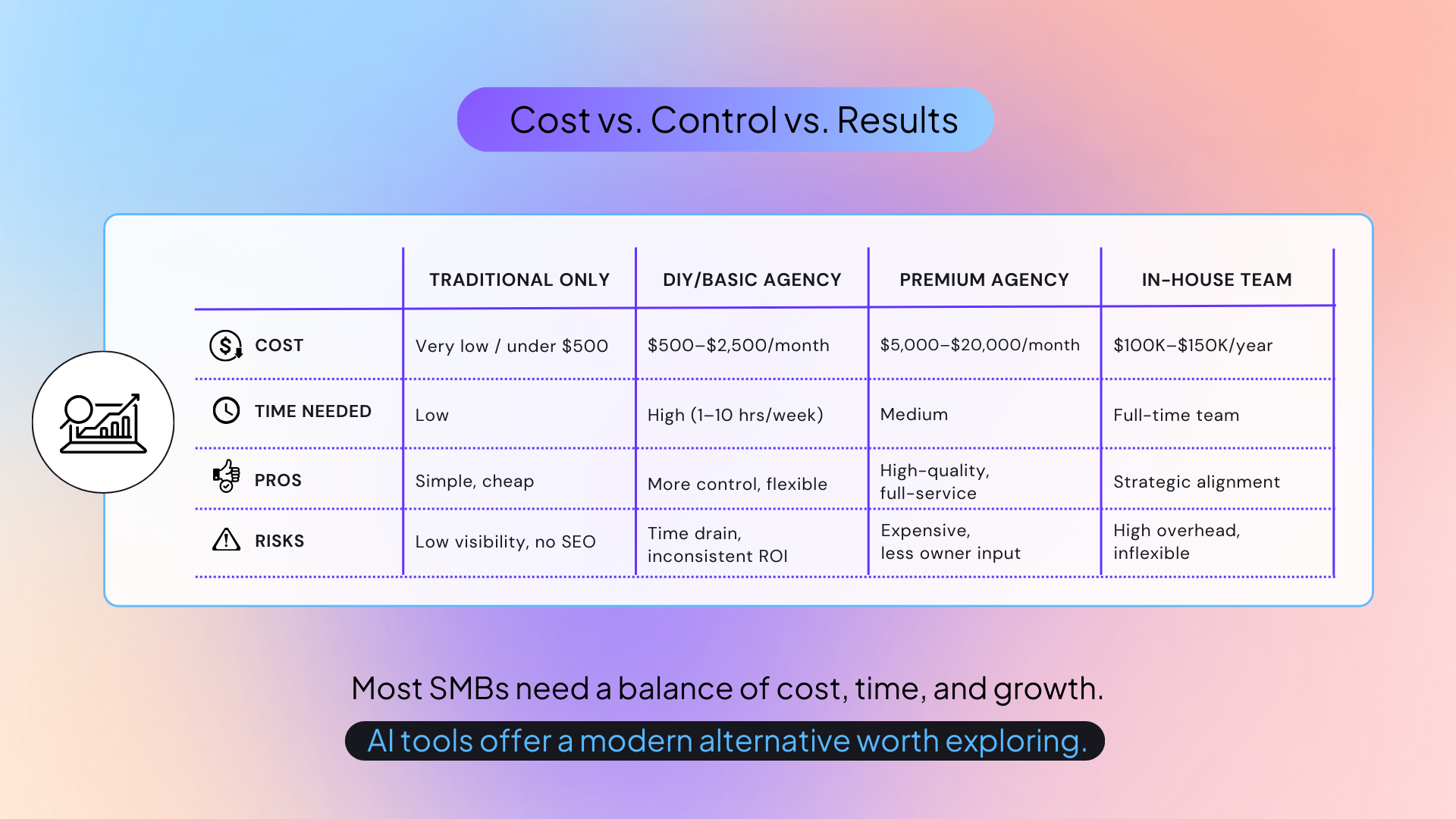
The Promises of AI
AI-driven solutions are widely acclaimed for outpacing manual human tasks in speed, cost-effectiveness, and scalability. As SMBs look for smarter efficiencies, advanced generative AI marketing tools like AgencyEngine’s website builder offer real value by integrating seamlessly into everyday workflows.
Below are five key ways AI delivers tangible growth in competitive local markets:
1. Automation & Efficiency
AI excels at handling repetitive, manual marketing tasks—saving substantial time and resources. In fact, 82% of SMBs adopting AI report higher operational effectiveness, freeing owners and marketers to focus on core strategic responsibilities rather than routine activities.
2. Data-Driven Personalization
By quickly analyzing customer data, generative AI personalizes marketing outreach that was once possible only for larger enterprises. For 77% of SMBs using AI, customized data-driven messaging is a key advantage that allows them to compete effectively against bigger brands.
3. Democratizing Access to Marketing Expertise:
AI makes sophisticated marketing tools accessible to SMBs, bridging the gap that once only larger enterprises could fill. This democratization enables smaller businesses to leverage the same advanced strategies, fostering a competitive edge in the market.
4. Real-Time Optimization
AI tools monitor campaigns and market changes continuously, enabling SMBs to make immediate strategy adjustments. According to 69% of small businesses, this responsiveness significantly enhances cost management and overall marketing ROI.
5. Enhanced Website Management & Lead Generation
Generative AI can improve site content quality, relevance, and SEO, leading to more robust lead capture and conversion. Notably, 69% of SMBs credit AI-powered marketing for enabling sustained growth, even in challenging economic periods .
Despite these advantages, AI adoption in marketing has often fallen short, with superficial outputs missing the strategic nuances and optimization steps typically supplied by skilled digital marketers. This gap highlights the need for AI platforms that combine powerful automation with domain expertise to truly fulfill the promise of AI‑driven marketing.
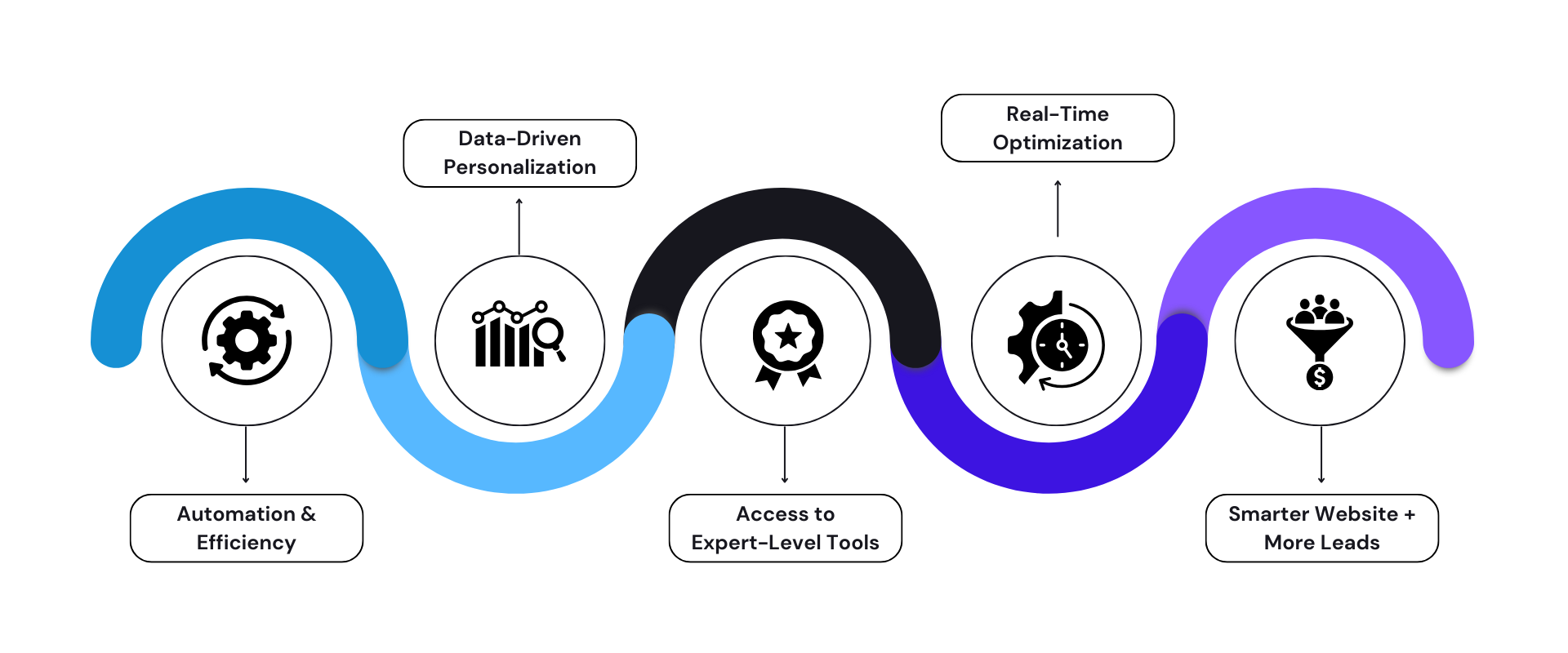
The Generative AI Marketing Advantage
For SMBs, the real strength of AI lies in automating the hundreds of repetitive, low-complexity tasks that pull marketing consultants away from high-level strategy.
Beyond processing routine activities at greater speed, AI enables real-time iteration on a broad scale, which can be broken down into steps:
1. Identify Relevant Keywords:
Uncover niche‑specific, high‑impact search terms automatically.
2. Run SERP Queries:
Pinpoint top‑ranking competitors for each strategic keyword.
3. Competitor List Generation:
Compile a complete inventory of rivals based on SERP data.
4. Deep Attribute Analysis:
Evaluate hundreds of competitor attributes, establishing valuable benchmarks.
5. Merchant Parameter Comparison:
Map competitor insights directly to the SMB’s existing digital presence.
6. Collaborative Review for Merchant Input:
Interact with business owners to clarify gaps or refine conclusions.
7. Strategic Website Blueprint:
Convert finalized competitive parameters into actionable site improvements.
With a generative AI tool platform like AgencyEngine, these otherwise time‑intensive tasks are executed by AI before creating a single line of content for an SMB client.
Data indicates that AI‑based marketing solutions cover the core needs for more than 90% of small and medium‑sized businesses. The remaining fraction, with specialized requirements, can still benefit from AI for foundational tasks—freeing human experts to focus on the bespoke elements of a marketing plan that truly need a personal touch.
Just as early CMS platforms like WordPress simplified the process of building a website, tools like AgencyEngine now democratize SMB digital marketing at scale.
By leveraging AI, SMBs not only boost efficiency but also gain competitive advantages once reserved for larger companies. The inherent flexibility of small businesses makes them especially well‑suited to adopt these technologies and realize growth that was once out of reach.
Strengthening Your Platform’s Offering
Discover how integrating AI-powered marketing solutions can transform your platform’s value proposition for local SMBs:
Enhanced ROI and Revenue Streams
A well-executed marketing strategy with AI can drive revenue growth, offering scalable solutions through upsells and subscription models that boost recurring revenue. SMEs using AI grow revenues 5-15% faster than competitors.
Example: Utilizing a generative AI website builders to quickly create and launch tailored websites, attracting more clients and boosting conversions.
Effect on Revenue
Improved marketing directly influences revenue growthBusinesses experience higher satisfaction and loyalty, leading to potential churn reduction. With precise forecasts and projections, SMEs can optimize planning to accelerate growth by 7-11% annually.
Example: Providing AI-driven website personalization features that enhance user experience
Cost Savings with AI
Leverage AI to lower labor costs and decrease overhead. Automating repetitive tasks with AI slashes costs substantially, with SMEs reducing operational costs by 22-33% through AI automation.
Example: Automating website updates and maintenance with AI to save time and resources, ensuring sites remain current and effective.
Value for Platforms
By offering integrated marketing tools, platforms can create additional recurring revenue streams and increase customer retention as SMBs witness real results. Stand out in a competitive marketplace by delivering added-value services.
Example: Offering platforms the ability to incorporate generative AI tools, enabling them to provide seamless, innovative solutions to their clients.
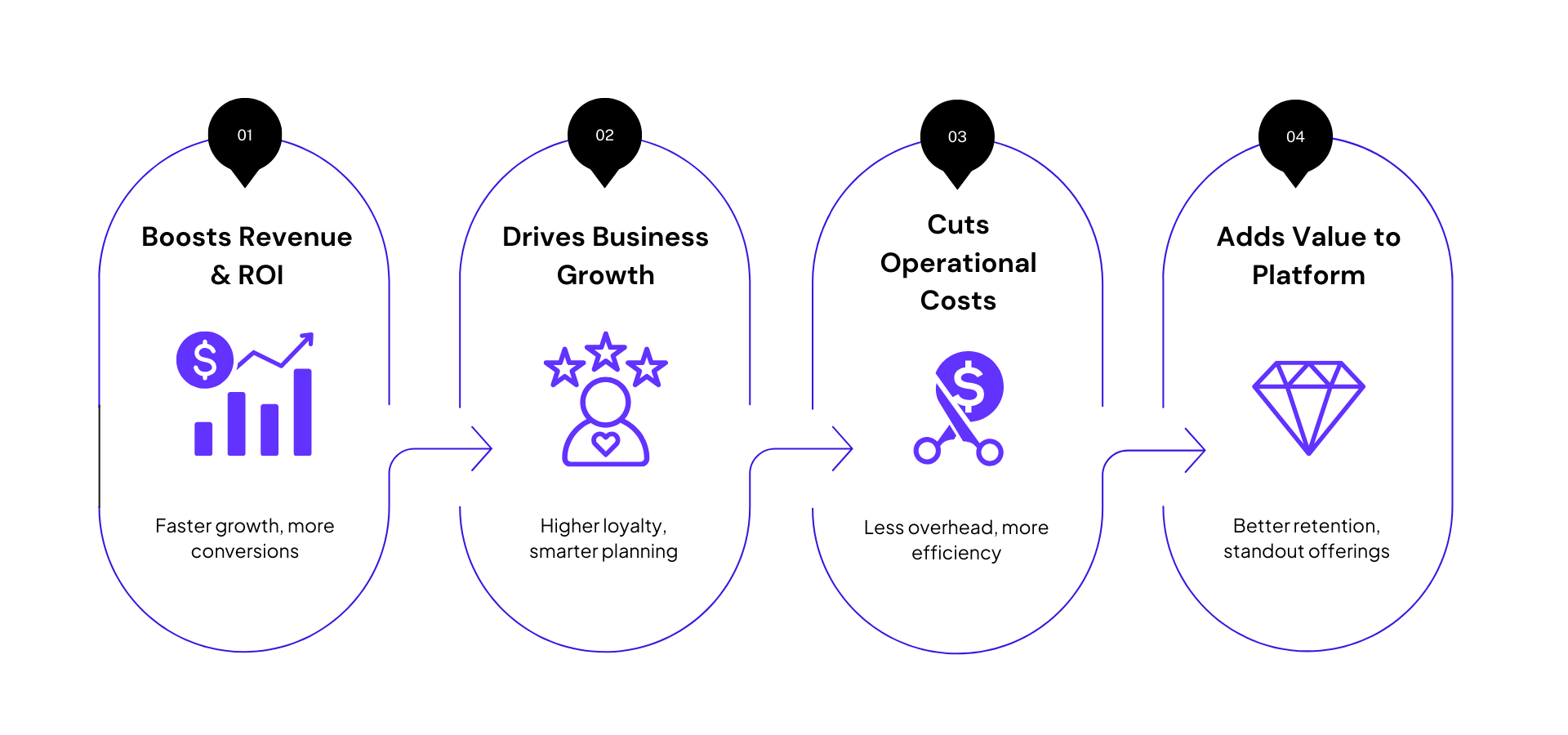
In summary, AI adoption is fuelling record growth levels for SMEs. Leveraging AI tools for automation, analytics, and customer engagement can lead to transformative outcomes through reduced costs, increased sales, and improved decision-making. SMEs that fail to incorporate AI into their operations risk falling behind the competition.
Next Steps
Platforms serving SMBs stand to achieve meaningful differentiation and growth by embedding AI-driven marketing solutions into their existing offerings. SMB users experience tangible improvements, making it easier to justify continuing subscription expenditures—thus creating stronger retention, lower churn, and notable business growth for both sides.
Ready to explore embedding AI-powered marketing within your own platform’s ecosystem? Reach out for a walkthrough or customized consultation—learn how powerful this approach can be for SMB success and platform revenue growth.
Ready to Elevate Your CRM Experience?
Discover how AgencyEngine combines AI website builder technology, marketing automation, and local SEO capabilities into one integrated marketing platform.




